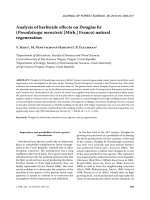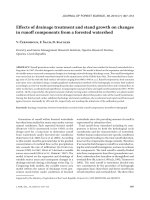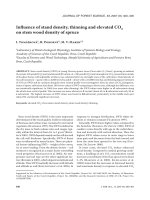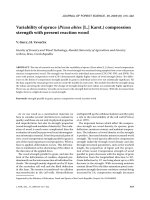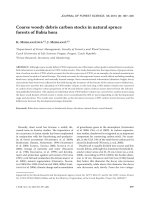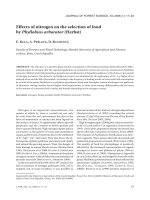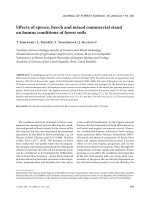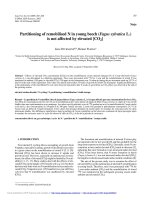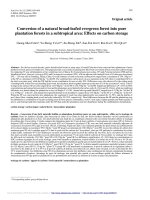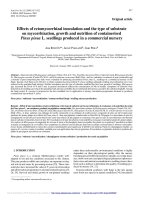Báo cáo lâm nghiệp: "Effects of elevated carbon dioxide on leaf gas exchange and growth of cork-oak (Quercus suber L) seedlings " pps
Bạn đang xem bản rút gọn của tài liệu. Xem và tải ngay bản đầy đủ của tài liệu tại đây (486.43 KB, 7 trang )
Short
note
Effects
of
elevated
carbon
dioxide
on
leaf
gas
exchange
and
growth
of
cork-oak
(Quercus
suber
L)
seedlings
C
Damesin,
C
Galera,
S
Rambal,
R
Joffre
Centre
d’écologie
fonctionnelle
et
évolutive,
CNRS,
BP
5051,
34033
Montpellier
cedex
01,
France
(Received
18
November
1994;
accepted
31
October
1995)
Summary —
Leaf
gas
exchange
and
growth
were
determined
on
cork-oak
(Quercus
suber L)
seedlings
which
were
grown
from
acorns
for
periods
of
up
to
4
months
in
greenhouses
at
ambient
(350
μmol
mol
-1
)
and
at
elevated
(700
μmol
mor
-1
)
concentrations
of
carbon
dioxide.
In
well-watered
conditions,
daily
max-
imum
photosynthesis
(15
μmol
m
-2
s
-1
)
and
stomatal
conductance
(440
mmol
m
-2
s
-1
)
of
plants
grown
and
measured
at
700
μmol
mol
-1
CO
2
did
not
differ
from those
of
plants
grown
and
measured
at
350
μmol
mol
-1
.
In
conditions
of
moderate
drought,
net
CO
2
assimilation
was
at
least
twice
as
great
in
elevated
CO
2,
but
stomatal
conductance
was
unchanged.
Elevated
CO
2
affected
total
biomass
pro-
duction,
the
average
increase
being
76
and
97%
at
3
and
4
months,
respectively.
Shoot
biomass,
root
biomass,
stem
height
and
total
leaf
area
were
increased
by
elevated
CO
2.
Root
and
stem
ramifi-
cation
were
also
enhanced
by
elevated
CO
2,
but
no
change
in
root/shoot
ratio
was
observed.
Quercus
suber /
carbon
dioxide
/
photosynthesis
/
stomatal
conductance
/
growth
Résumé —
Effets
d’une
augmentation
du
CO
2
atmosphérique
sur
les
échanges
gazeux
et
la
crois-
sance
de
plantules
de
chêne-liège
(Quercus
suber
L).
Des
mesures
de
croissance
et
d’échanges
gazeux
ont
été
menées
sur
des
plantules
de
chêne-liège
(Quercus
suber
L)
de 3
et
4
mois
qui
ont
grandi
avec
une
concentration
en
dioxyde
de
carbone
de
350
μmol
mol
-1
ou
de
700
μmol
mol
-1
.
Dans
des
conditions
non
limitantes
en
eau,
la
photosynthèse
(15
μmol
m
-2
s
-1
)
et
la
conductance
stomatique
(440
mmol
m
-2
s
-1
)
maximales
journalières,
mesurées
avec
la
concentration
de
CO
2
de
croissance,
n’étaient
pas
différentes
entre
les
deux
traitements.
En
conditions
de
stress
hydrique
modéré,
la
pho-
tosynthèse
nette
était
deux
fois
plus
élevée
en
CO
2
double,
alors
que
les
conductances
stomatiques
sont
restées
égales
entre
les
deux
traitements.
La
biomasse
des jeunes
chênes-lièges
était plus
éle-
vée
quand
ils
ont
poussé
à
700
μmol
mol
-1
,
le
gain
étant
de
76
et
97
%
à
trois
et
quatre
mois
respec-
tivement.
La
biomasse
des
tiges,
des
racines,
la
longueur
de
la
tige
principale
et
la
surface
foliaire
totale
ont
été
augmentées
en
CO
2
double.
Les
ramifications
des
tiges
et
racines
étaient plus
nombreuses
en
CO
2
élevé
mais
aucune
variation
du
rapport
racine/tige
n’a
été
observée.
Quercus
suber
/ dioxyde
de
carbone
/ photosynthèse
/ conductance
stomatique
/ croissance
INTRODUCTION
To
understand
and
predict
the
impact
of
increasing
CO
2
upon
natural
vegetation,
it
is
necessary
to
determine
the
nature
and
the
direction
of
the
responses
in
a
range
of
plant
species.
In
this
paper,
we
investigate
the
effects
of
elevated
CO
2
on
Quercus
suber
L
seedlings,
a
Mediterranean
evergreen
oak.
Because
the
behaviour
of
a
tree
may
sig-
nificantly
differ
between
its
juvenile
and
its
reproductive
age,
one
cannot
use
the
results
concerning
competitiveness
of
seedlings
to
predict
mature
tree
behaviour.
However,
any
change
in
environmental
conditions
dur-
ing
the
first
stages
of
a
plant
can
have
impor-
tant
consequences
on
the
spatial
and
tem-
poral
vegetation
patterns
(Olsvig-Whittaker
et al,
1992).
Indeed,
growth
characteristics
of
seedlings
will
determine
the
success
of
a
species
and
lead
to
a
process
of
recruit-
ment
or
extinction
(Bazzaz,
1979).
Apart
from
seed
size,
physiological
per-
formances
and
allocation
patterns
play
a
major
role
in
seedlings’
adaptation
to
the
environment.
Most
research
on
the
effects
of
enhanced
CO
2
emphasized
photosynthe-
sis
because
of
its
direct
relationship
to
plant
survival
and
growth
through
the
carbon
bal-
ance.
However,
the
arrangement
of
foliage,
branching
patterns
and
root/shoot
ratio
are
also
important
because
they
determine
the
access
to
environmental
resources.
CO
2
has
been
reported
to
be
able
to
change
both
plant
physiology
and
growth
(Field
et
al,
1992;
Mousseau
and
Saugier,
1992).
Gen-
erally,
total
growth
of
a
plant
is
increased
by
elevated
CO
2
(Eamus
and
Jarvis,
1989),
but
leaf
gas
exchange
appear
more
unpre-
dictable.
During
long-term
experiments
(weeks
or
months),
a
down
regulation
of
photosynthetic
activity
is
often
observed
(Ceulemans
and
Mousseau,
1994).
More-
over,
interactive
effects
of
CO
2
concentration
and
other
environmental
variables
such
as
water
availability
may
affect
the
response
of
plants
to
CO
2
(Bowes,
1993;
Guehl
et
al,
1994;
Idso
and
Idso,
1994).
The
objective
of
this
study
was
to
deter-
mine
the
effects
of
an
increase
in CO
2
con-
centration
on
the
carbon
gain
of
Quercus
suber seedlings.
We
examined
the
effects
of
CO
2
enhancement
i)
on
leaf
gas
exchange
under
well-watered
conditions
and
moderate
drought
and
ii)
on
biomass
production
and
partitioning.
MATERIALS
AND
METHODS
Growth
conditons
Quercus
suber
L acorns
were
potted
in
5
L
pots
filled
with
a
substrate
made
of
85%
loamy
soil
and
15%
compost.
Each
pot
contained
three
acorns.
Seedlings
germinated
in
late
April.
Slow
release
fertilization
(24
g
per
pot
of
Nutricote
100,
N/P/K:
13/13/13)
complemented
with a mixture
of
oligoelements
was
added
in
order
to
avoid
nutrient
limitations.
Seedlings
were
grown
under
ambient
(350
μmol
mol
-1
)
or
elevated
(700
μmol
mol
-1
)
concentrations
of
atmospheric
CO
2.
Dur-
ing
growth,
relative
air
humidity
in
the
green-
houses
was
kept
at
outside
values
and
plants
received
natural
light
with
little
effect
of
green-
house
structure.
Minimum
temperatures
for
May,
June,
July
and
August
were
15.8, 19.1,
20.9
and
21.6
°C,
respectively.
For
the
same
period,
max-
imum
temperatures
were
25.5,
30.7,
31.3
and
33.6
°C.
During
the
days
with
physiological
mea-
surements,
relative
air
humidity
was
maintained
at
60%.
Maximum
temperature
and
photosyn-
thetically
active
radiation
were
35
°C
and
1
900
μmol
m
-2
s
-1
,
respectively.
Gas
exchange
and
water
potential
measurements
Seedlings
were
watered
daily.
Irrigation
was
dis-
continued
for
six
pots
per
greenhouse
from
15
July
(d196)
to
27
July
1993
(d208).
Measure-
ments
were
taken
during
8
and
5
sunny
days,
respectively,
in
ambient
and
elevated
CO
2.
Plant
water
status
was
characterized
by
predawn
leaf
water
potential
measured
with
a
pressure
cham-
ber
(PMS
Instrument
Company,
Corvallis,
OR,
USA).
In
each
greenhouse,
two
seedlings
with
the
same
potential
were
chosen
for
leaf
gas
exchange.
Measurements
were
made
in
the
greenhouse
where
plants
were
grown,
on
three
leaves
per
seedling,
every
2
h
from
dawn
to
dusk.
Stomatal
conductance
was
measured
with
a
LI:1600
steady-state
porometer
(LI-Cor,
Inc,
NE,
USA)
and
net
photosynthesis
with
an
infrared
CO
2
gas
analyser
model
CI-301 PS
(CID,
Inc,
Vancouver,
Canada),
using
a
2.5
cm
2
leaf
cham-
ber.
Daily
maximum
photosynthesis
and
stom-
atal
conductance
were
chosen
to
characterize
leaf
gas
exchange.
They
occurred
between
0900
and
1000
hours
local
solar
time
when
air
tem-
perature
was
28
±
2
°C
and
photosynthetically
active
radiation
above
1
600
μmol
m
-2
s
-1
.
Growth
measurements
and
nitrogen
concentration
Twelve
3-month-old,
and
15
4-month-old
seedlings,
maintained
in
well-watered
conditions,
were
used
for
morphological
analyses.
Each
seedling
was
harvested
and
divided
into
roots,
stems
and
leaves.
Expanding
leaves,
secondary
roots
and
stems
were
segmented.
Biomass
of
each
part,
length
of
the
main
root
and
stem,
and
total
leaf
area
were
recorded
on
an
individual
basis.
Areas
of
the
fresh
leaves
were
determined
with
a
video
leaf-area
meter
(Delta-T
Image
Anal-
ysis
System,
Delta-T
Devices,
Ltd,
UK).
All
the
parts
were
dried
at
60 °C
for
2
days
and
then
weighed.
Chemical
analyses
were
done
on
the
4-month-
old
plants
(n
=
15
for
each
CO
2
treatment).
For
each
seedling,
all its
dried
mature
leaves
were
mixed
and
ground.
The
mass-based
nitrogen
con-
centration
was
measured
by
near-infrared
spec-
troscopy
following
a
procedure
described
by
Jof-
fre
et
al
(1992).
For
each
sampling
date,
growth
data
and
nitrogen
concentration
between
the
two
treatments
were
compared
with
Student’s
t-test.
Differences
were
considered
significant
if
proba-
bilities
were
less
than
0.05.
RESULTS
Leaf gas
exchange
Figure
1
shows
changes
of
maximal
photo-
synthesis
and
stomatal
conductance
versus
predawn
leaf
water
potential.
Under
well-
watered
conditions,
whatever
the
CO
2
par-
tial
pressure,
maximal
net
photosynthesis
and
stomatal
conductance
measured
dur-
ing
daytime
were,
respectively,
about
15
μmol
m
-2
s
-1
and
440
mmol
m
-2
s
-1
.
In
response
to
water
stress,
photosynthesis
and
stomatal
conductance
decreased
at
both
350
and
700
μmol
mol
-1
.
The
relation-
ships
between
predawn
water
potential
and
the
stomatal
conductance
were
similar
for
both
CO
2
treatments.
The
decrease
of
net
assimilation
rates
with
predawn
potential
was
slower
under
elevated
CO
2
than
under
ambient
CO
2.
At
-1.2
MPa,
maximal
pho-
tosynthesis
was
around 5
and
10
μmol
m
-2
s
-1
at
350
and
700
μmol
mol
-1
,
respectively.
Under
elevated
CO
2,
some
substantial
pho-
tosynthesis
values
(2.5 μmol
m
-2
s
-1
)
were
observed
at
very
low
potentials
(-5
MPa).
Growth
measurements
and
nitrogen
concentration
Exposure
to
elevated
CO
2
resulted
in
a
sig-
nificant
increase
of
total
biomass
in
Quercus
suber
seedlings
(t = -3.97,
P
< 0.001
at
3
months;
t -4.77,
P <
0.001
at
4
months;
fig
2).
Increases
were
76
and
97%
at
3
and
4
months,
respectively.
On
both
dates,
each
biomass
compartment
was
significantly
larger
at
700
than
at
350
μmol
mol
-1
(fig
2).
At
3
months,
leaf,
root
and
stem
dry
mass
increased
respectively
by
58,
92
and
95%
in
plants
grown
under
elevated
relative
to
ambient
CO
2.
At
4
months,
leaf
and
espe-
cially
stem
biomass
increases
were
greater
(72
and
148%,
respectively)
than
at
3
months.
On
the
contrary,
the
root
biomass
increase
was
less
(76%).
The
ranking
of
each
plant
compartment
in
terms
of
relative
biomass
was
kept
constant
at
both
treat-
ments
(leaves
> stems
> roots).
After
3
months
of
exposure
to
elevated
CO
2,
main
root,
main
stem
length
and
leaf
mass
per
area
were
increased
respectively
by
72,
25
and
28%
(table
I).
These
increases
were
significant
at
both
dates.
Total
leaf
area
was
higher
at
700
μmol
mol
-1
,
but
this
difference
was
only
signifi-
cant
at
4
months.
High
CO
2
did
not
lead
to
a
significant
effect
on
the
root/shoot
ratio.
At
3
months,
the
ratio
of
secondary
root
mass
to
total
root
mass
was
significantly
different
between
the
two
CO
2
treatments
(fig
3).
This
difference
disappeared
at
4
months.
The
ratio
of
secondary
stem
mass
to
total
stem
mass
and
the
ratio
of
non-fully
expanded
leaves
to
total
leaf
biomass
were
significantly
higher
at
700
than
for
350
μmol
mol
-1
at
both
dates.
Growth
under
elevated
CO
2
resulted
in
a
significant
decrease
of
leaf
nitrogen
concentration
(table
I).
DISCUSSION
After
3
months,
and
under
well-watered
con-
ditions,
daily
maximum
photosynthesis
and
stomatal
conductance
of
Quercus
suber
seedlings
at
ambient
and
elevated
CO
2
were
similar.
Bunce
(1992)
measured
sim-
ilar
values
of
leaf
conductance
on
seedlings
of
two
deciduous
oaks
(Quercus
prinus
and
Q
robur)
under
700
and
300
μmol
mol
-1
CO
2.
Between
350
and
700
μmol
mol
-1
,
one
could
have
expected
an
enhancement
of
net
photosynthesis.
However,
contradic-
tory
results
are
reported
in
the
literature.
Even
within
the
same
genus,
responses
to
CO
2
enhancement
differ
among
species.
For
example,
Idso
et
al
(1991)
reported
an
increase
of
carbon
exchange
rate
at
ele-
vated
CO
2
on a
deciduous
oak,
Q
alba,
but,
as
with
Q
suber in
this
study,
they
found
similar
photosynthetic
rates
between
CO
2
treatments
for
Q
robur.
We
observed
a
decrease
of
leaf
nitrogen
concentration
of
Q suber seedlings
in
elevated
CO
2.
As
pho-
tosynthesis
is
often
strongly
positively
related
with
nitrogen
in
leaves
(Evans,
1989),
this
decrease
could
lead
to
a
limita-
tion
of
photosynthesis
capacity
under
ele-
vated
CO
2.
Such
a
decrease
has
been
observed
in
a
range
of
tree
species
(Johnsen,
1993;
Julkunen-Tiitto
et al,
1993;
Lindroth
et
al,
1993;
Duff
et
al,
1994).
By
comparing
oaks
growing
naturally
in
elev-
ated
CO
2
with
those
growing
in
ambient
CO
2,
Körner
and
Miglietta
(1994)
found
a
decrease
of
the
leaf
nitrogen
concentration
for
a
deciduous
oak,
Q
pubescens,
but
an
increase
for
an
evergreen
oak,
Q
ilex.
When
water
stress
takes
place
under
350
μmol
mol
-1
,
the
decrease
patterns
of
maximal
net
photosynthesis
and
stomatal
conductance
with
respect
to
predawn
leaf
water
potential
were
similar
to
those
obtained
for
the
same
species
by
Acherar
et
al
(1991)
on
3-year-old
seedlings
under
con-
trolled
conditions,
and
by
Tenhunen
et
al
(1987)
on
mature
trees
in
the
field.
As
water
stress
occurred,
intrinsic
water-use
effi-
ciency,
defined
as
the
ratio
of
maximal
pho-
tosynthesis
to
maximal
leaf
conductance,
increased
under
elevated
CO
2.
If
we
only
consider
the
photosynthesis
results
related
to
leaf
gas
exchange,
an
ele-
vation
of
CO
2
would
not
be
of
benefit
for
the
water
and
carbon
balances
of
well-
watered
seedlings.
However,
results
regard-
ing
the
growth
of
seedlings
indicate
that
enhanced
CO
2
significantly
increased
car-
bon
balance
at
the
whole-plant
level.
These
increments
were
closer
to
the
average
incre-
ment
observed
in
deciduous
(+63%)
than
in
coniferous
trees
(+38%),
as
reported
by
Ceulemans
and
Mousseau
(1994).
They
are
comprised
between
the
biomass
increase
over
one
growing
season
observed
in
Q
petraea
(+138%)
and
Pinus
pinaster
(+63%)
(Guehl
et
al,
1994).
In
Q
suber,
root
and
shoot
biomass,
and
total
leaf
area
were
increased,
like
in
Populus
grandidentata
Michx
(Curtis
and
Teeri,
1992).
An
increase
of
root/shoot
ratio
is
frequently
observed
in
elevated
CO
2
(Ceulemans
and
Mousseau,
1994).
Nevertheless,
as
Bunce
(1992)
observed
for
Q
robur,
we
found
no
change
in
the
investment
of
biomass
to
roots
relative
to
shoots.
The
greater
proportion
of
fully-
expanded
leaves
at
700
μmol
mol
-1
sug-
gests
that
shoot
growth
was
almost
contin-
uous.
Stem
and
root
biomass
as
well
as
their
degree
of
ramification
were
increased
by
an
elevation
of
CO
2.
This
different
archi-
tecture
could
improve
Q
suber
establish-
ment
in
elevated
CO
2
in
the
field
where
competition
with
grasses
plays
an
impor-
tant
role
in
tree
seedlings
establishment
(Griffin
1971;
McPherson,
1993).
The
increase
in
twig
growth
in
elevated
CO
2
could
lead
to
a
rapid
construction
of
sun
leaves
above
the
grass
layer
(McCarthy
and
Dawson,
1990).
The
increases
of
root
growth,
root
length
and
the
higher
number
of
ramifications
may
allow
the
exploitation
of
a
greater
volume
of
soil
and
thus,
water
and
nutrient
extraction
in
soil
layers
not
exploited
by
competitors
(Gordon
and
Rice,
1993).
Enhancement
of
root
growth,
root
length
and
fine
root
mass
have
been
already
reported
on
tree
species
(Idso
and
Kimball,
1992;
Norby
et
al,
1992;
Pettersson
et
al,
1993).
Experiments
with
competitors
under
elevated
CO
2
are
needed
to
determine
ulti-
mately
the
success
of
Q
suber
seedling
establishment
in
a
future
CO
2
environment.
It
is
surprising
to
find
an
increase
of
total
biomass
when
at
the
same
time,
leaf
pho-
tosynthesis
is
not
improved
by
elevated
CO
2.
This
may
be
due
to
an
acclimation
to
elevated
CO
2,
similar
to
the
one
described
by
El
Kohen
et
al
(1993)
on
Castanea
sativa.
The
enhancement
of
net
photosynthesis
only
in
the
first
days
after
emergence
leads
to
a
greater
initial
growth
rate
and
to
a
greater
total
leaf
area
(Gaudillère
and
Mousseau,
1989)
which
could
promote
a
large
difference
of
biomass
production
at
the
plant
level.
ACKNOWLEDGMENTS
The
financial
and
technical
supports
were
pro-
vided
by
the
CEFE-CNRS,
IGBP
Ecosystem
pro-
gram
and
European
Union
MOST
project
(con-
tract
no
EV5V-CT92-0210).
The
authors
gratefully
acknowledge
A
Freeman
for
her
linguistic
con-
tribution.
REFERENCES
Acherar
M,
Rambal
S,
Lepart
J
(1991)
Evolution
du
potentiel
hydrique
foliaire
et
de
la
conductance
stom-
atique
de
quatre
chênes
méditerranéens
lors
d’une
période
de
dessèchement.
Ann
Sci For 48,
561-573
Bazzaz
FA
(1979)
The
physiological
ecology
of
plant
succession.
Ann Rev Ecol Syst 10, 351-371
Bowes
G
(1993)
Facing
the
inevitable:
plants
and
increasing
atmospheric
CO
2.
Ann
Rev
Physiol
Plant
Mol Bioi 44.
309-332
Bunce
JA
(1992)
Stomatal
conductance,
photosynthesis
and
respiration
of
temperate
deciduous
tree
seedlings
grown
outdoors
at
an
elevated
concen-
tration
of
carbon
dioxide.
Plant
Cell
Environ
15,
541-
549
Ceulemans
R,
Mousseau
M
(1994)
Effects
of
elevated
atmospheric
CO
2
on
woody
plants.
Tansley
Review
no
71.
New
Phytol 127,
425-446
Curtis
PS,
Teeri
JA
(1992)
Seasonal
responses
of leaf
gas
exchange
to
elevated
carbon
dioxide
in
Populus
grandidentata.
Can
J For
Res
22,
1320-1325
Duff
GA,
Berryman
CA,
Eamus
D
(1994)
Growth,
biomass
allocation
and
foliar
nutrient
contents
of
two
Eucalyptus
species
of
the
wet-dry
tropics
of
Aus-
tralia
grown
under
CO
2
enrichment.
Funct
Ecol 8,
502-508
Eamus
D,
Jarvis
PG
(1989)
The
direct
effects
of
increase
in
the
global
atmospheric
CO
2
concentration
on
nat-
ural
and
commercial
temperate
trees
and
forests.
Adv Ecol Res 19, 1-55
El
Kohen
A,
Venet
L,
Mousseau
M
(1993)
Growth
and
photosynthesis
of
two
deciduous
forest
species
at
elevated
carbon
dioxide.
Funct
Ecol7,
480-486
Evans
JR,
(1989)
Photosynthesis
and
nitrogen
rela-
tionships
in
leaves
of
C3
plants.
Oecologia 78,
9-19
Field
CB,
Stuart
Chapin
F
III,
Matson
PA,
Mooney
HA
(1992)
Responses
of
terrestrial
ecosystems
to
the
changing
atmosphere.
A
resource-based
approach.
Ann
Rev Ecol
Syst 23,
201-235
Gaudillère
JP,
Mousseau
M
(1989)
Short
term
effect of
CO
2
enrichment
on
leaf
development
and
gas
exchange
of
young
poplars
(Populus
euramericana
cv
I
). Acta
Oecologia
Oecol
Plant
10,
95-105
Gordon
DR ,
Rice
KJ
(1993)
Competitive
effects
of
grass-
land
annuals
on
soil
water
and
blue
oak
(Quercus
douglasii)
seedlings.
Ecology
74,
68-82
Griffin
JR
(1971)
Oak
regeneration
in
the
upper
valley,
California.
Ecology 52,
862-868
Guehl
JM,
Picon
C,
Aussenac
G,
Gross
P
(1994)
Inter-
active
effects
of
elevated
CO
2
and
soil
drought
on
growth
and
transpiration
efficiency
and
its
determi-
nants
in
two
European
forest
tree
species.
Tree
Physiol 14,
707-724
Idso
SB,
Kimball
BA
(1992)
Seasonal
fine-root
biomass
development
of
sour
orange
trees
in
atmosphere
of
ambient
and
elevated
CO
2
concentration.
Plant
Cell
Environ
15,
337-341
Idso
KE,
Idso
SB
(1994)
Plant
responses
to
atmospheric
CO
2
enrichment
in
the
face
of
environmental
con-
straints:
a
review
of
the
past
10
years
research.
Agric
For Meteorol 69,
153-203
Idso
SB,
Kimball
BA,
Allen
SG
(1991)
Net
photosyn-
thesis
of
sour
orange
trees
maintained
in
atmosphere
of
ambient
and
elevated
CO
2
concentration.
Agric
For
Meteorol 54,
95-101
Joffre
R,
Gillon
D,
Dardenne
P,
Agneessens
R,
Biston
R
(1992)
The
use
of
near-infrared
spectroscopy
in
lit-
ter
decomposition
studies.
Ann
Sci
For 49,
481-488
Johnsen
KH
(1993)
Growth
and
ecophysiological
responses
of
black
spruce
seedlings
to
elevated
CO
2
under
varied
water
and
nutrient
additions.
Can
J
For
Res
23,
1033-1042
Julkunen-Tiitto
R,
Tahvanainen
J,
Silvola
J
(1993)
Increased
CO
2
and
nutrient
status
changes
affect
phytomass
and
the
production
of
plant
defensive
secondary
chemicals
in
Salix
myrsinifolia
(Salisb).
Oecologia
95,
495-498
Körner
C,
Miglietta
F
(1994)
Long
term
effects
of
naturally
elevated
CO
2
on
Mediterranean
grassland
and
for-
est
trees.
Oecologia
99,
343-351
Lindroth
RL,
Kinney
KK,
Platz
CL
(1993)
Responses
of
deciduous
trees
to
elevated
atmospheric
CO
2:
pro-
ductivity,
phytochemistry,
and
insect
performance.
Ecology 74,
763-777
McCarthy
JJ,
Dawson
JO
(1990)
Growth
and
water
use
efficiency
of
Quercus
alba,
Q
bicolor,
Q
imbricaria,
and
Q
palustris
seedlings
under
conditions
of
reduced
soil
water
availability
and
solar
irradiance.
Trans III
State
Acad
Sci
83,
128-148
McPherson
GR
(1993)
Effects
of
herbivory
and
herb
interference
on
oak
establishment
in
a
semi-arid
temperate
savanna.
J
Veg
Sci
4,
687-692
Mousseau
M,
Saugier
B
(1992)
The
direct
effect
of
increased
CO
2
on
gas
exchange
and
growth
of
for-
est
tree
species.
J
Exp
Bot
43,
112
1-1130
Norby
RJ,
Gunderson
CA,
Wullschleger
SD,
O’Neill
EG,
McCracken
MK
(1992)
Productivity
and
compen-
satory
response
of
yellow
poplar
trees
in
elevated
CO
2.
Nature
357, 322-324
Olsvig-Whittaker
LS,
Naveh
Z,
Giskin
M,
Nevo
E
(1992)
Microsite
differenciation
in
a
Mediterranean
oak
savanna.
J
Veg
Sci 3,
209-216
Pettersson
R,
McDonald
AJS,
Stadenberg
I (1993)
Response
of
small
birch
plants
(Betula
pendula
Roth)
to
elevated
CO
2
and
nitrogen
supply.
Plant Cell
Env-
iron 16,
1115-1121
Tenhunen
JD,
Beyshlag
W,
Lange
OL,
Harley
PC
(1987)
Changes
during
summer
drought
in
leaf
CO
2
uptake
rates
in
macchia
shrubs
growing
in
Portugal:
limitations
due
to
photosynthetic
capacity,
car-
boxylation
efficiency
and
stomatal
conductance
In:
Plant
Response
to
Stress.
Functional
Analysis
in
Mediterranean
Ecosystems
(JD
Tenhunen,
FM
Catarino,
OL
Lange,
WC
Oechel,
eds),
series
G,
Ecological
Science,
vol
15,
Springer-Verlag,
Berlin,
305-328
